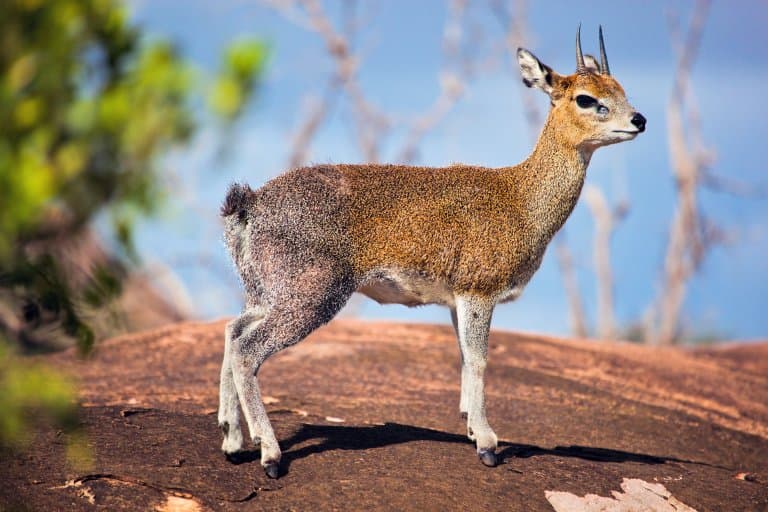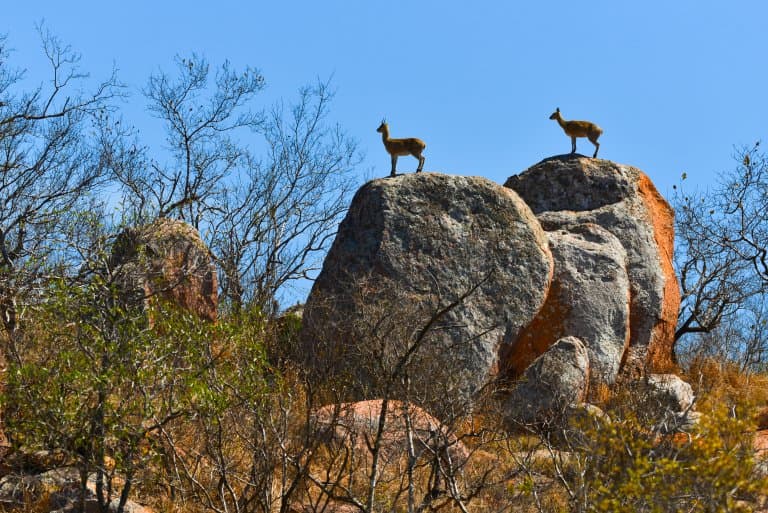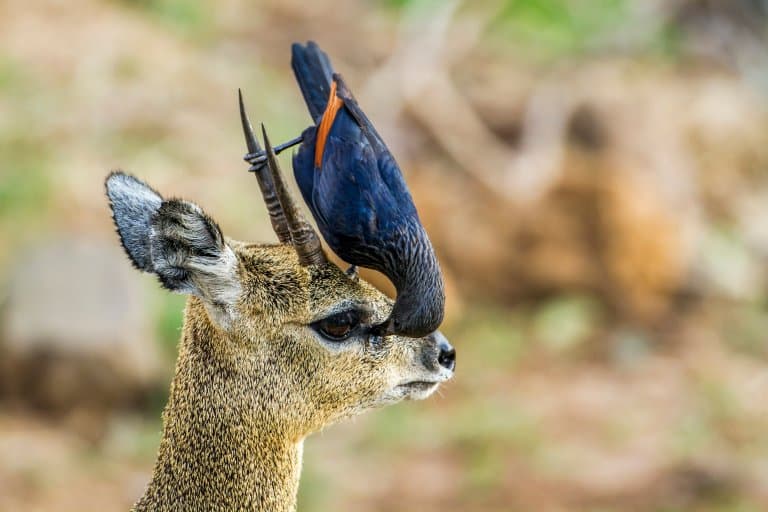Klipspringer Profile
One of the smallest antelopes in the world is also one of the nimblest.
It’s named for its agility among rocky outcrops; something that has led to some peculiar rumours about its leaping capacity.
But the klipspringer doesn’t need to defy physics to be interesting, it’s a successful animal in its own right, with a unique and adorable approach to life.
They live in eastern and southern Africa and inhabit rocky terrain, amongst open grasslands.

Klipspringer Facts Overview
| Habitat: | Rocky, sparsely-vegetated areas |
| Location: | Southern and Eastern Sub-Saharan Africa |
| Lifespan: | 15 years |
| Size: | 60 cm (2 ft) tall |
| Weight: | Up to 18 kg (40 lb) |
| Color: | Brown, gray |
| Diet: | Leaves, grasses and flowers |
| Predators: | Mountain leopards, caracals |
| Top Speed: | Unknown |
| No. of Species: |
1 |
| Conservation Status: |
Least concern |
Klipspringer translates from Afrikaans to ‘rock jumper‘, and it’s a great name for this tiny antelope. Its feet are perfectly designed for the role and help keep it safe from predators.
Young klipspringer are hidden in the relative safety of rock crevices, and their main predators come from animals, such as leopards, caracals and black eagles for whom the rocky terrain is less problematic.
Its tiny size also comes as an advantage, allowing it to pick and choose its food, and pairs will occupy small territories for life, marking out their boundaries using special scent glands that present as iconic dark eye spots on their face.
Klipspringers are herbivorous and mainly graze on rock plants, fruits, herbs, twigs, bark and lichens.
They’ve been hunted for their thick fur in the past, but in general, they’re doing very well and can be found widely distributed across Africa, humiliating predators by sitting just out of reach on rocks.
Interesting Klipspringer Facts
1. They’re small
This is a tiny antelope. Not quite the smallest, but definitely in the same class. They’re rarely more than 60 cm (2 ft) tall at the shoulder and weigh about as much as a border collie.
Females are the larger of the two sexes, but they’re both pretty mini, and they come with mini stomachs too. This means they don’t need much food and get to browse a selection to pick their finest nutritional options from the surrounding plants.
And they do this a fair bit. They’ll forage anywhere from 15% to 41% of their waking hours. Their small size and variety of plant options mean they don’t need to drink much at all. They rarely take water, instead gathering hydration from the thick, fleshy plants and stems they nibble on. 1

2. They’re clingy
Moreso than most mammals, Klipspringers are mostly monogamous. They pair-bond for a really long time, which people seem to like to hear.
It does get a little creepy though, when they will follow one another around, never more than 5 m away from one another.
But there’s a good reason for this proximity – They’re mostly nocturnal, and the male and female klipspringers take on traditional gender roles as a survival necessity.

3. They make a good team
These pairs will occupy territories. Not big ones, mind you; they’re not big animals, and humble, too. They’ll occupy a small patch of land they call home, and they’ll defend it enthusiastically.
Once they’re bonded, they’ll both play an active role in this, with the female taking on more of the foraging responsibilities and the male acting as a lookout. The male spends more time doing things that keep the female interested, and, as the smaller anima, eats less.
This frees up time for him to watch out for predators or intruders, the latter of which will be chased off by both males and females. 2
4. They find and defend one another using scent-bouts
Scent marking is one of the key ways the pair will defend their zone. In a scent-marking bout, one or the other of the pair will kick off and they’ll hurriedly get to work reinforcing their territorial boundaries with secretions from their faces and butts.
The quality of this defence is often what attracts the female to the male in the first place, but once they’re together it has to be maintained.
Interestingly, female klipspringers are the ones who mostly suggest one of these scent-marking bouts, but the males, once persuaded, are the more productive at it.
These bouts seem to involve a mixing of scent marks, where a male will overmark a female’s scent, suggesting that a combination of scents leaves more information than a single scent.
Females up their game when they’re receptive, prompting the males to prove themselves in a test of their quality as a mate. 3
5. They walk on tip-toes
These animals are so well adapted to their rocky environment they can navigate it effortlessly. Their hooves are are cylindrical and downward-pointing. Using these elongated pin-like feet, they step on the very tips of their hooves, able to grip onto the slightest projection of rock.
This is as much a defensive advantage as a foraging one, as it allows them to access areas that their predators can’t.
6. They whistle
Klipspringers vaocalize with each other with a shrill-like whistle through their nose. If one spots danger, they will alert their partner with a piercing whistle.
7. They are one of the world’s highest jumpers (well, maybe)?
Klipspringers are named for their impressive leap. Yet, nobody seems to be able to verify how high, and there’s no such video corroboration for it.
25ft is the popular myth, and San Diego Zoo suggests a less-exaggerated height of half that. Still, neither the mindless hordes nor the globally recognised research institution cared to supply any evidence to back this up.
It’s more likely that the name ‘rock jumper’ refers to their ability to hop between boulders – something which they are more than comfortable doing in the wild, and on many videos – and not their supernatural ability to leap over giraffes.

8. Not all klipspringer have horns
Klipspringers often have short, spiky horns and both males and females can have them.
In southern Africa, only males have horns. In east Africa, both males and females can have horns. It’s thought this is because these populations have experienced greater competitive interactions.
9. They have eye birds
 have been seen perched on the head of the klipspringer, feeding on the secretions from the large black scent glands on its face.
have been seen perched on the head of the klipspringer, feeding on the secretions from the large black scent glands on its face.
This might seem like it would be annoying, but it’s thought that they help keep the antelope free from smaller parasites and get a free meal in the process.
This form of mutualism is common in examples like the cattle egret and buffalo, but definitely looks stranger between the klipspringer and its friends.
10. They are hunted for meat, leather and hair
Despite being hunted, the klipspringer is classified by the IUCN as ‘least concern’.
Their fur was once much in demand for stuffing saddlebags and led to heavy hunting particularly in South Africa.
However, 25% of the population are in protected areas in national parks, their habitat is difficult to reach for hunting, and they don’t have to compete with livestock for food.
Its population numbers are healthy and are estimated to be over 40,000 in the wild, and there are no major threats to its survival.
Klipspringer Fact-File Summary
Scientific Classification
| Kingdom: | Animalia |
| Phylum: | Chordata |
| Class: | Mammalia |
| Order: | Artiodactyla |
| Family: | Bovidae |
| Genus: | Oreotragus |
| Species Name: |
Oreotragus Oreotragus |
Fact Sources & References
- Bireda, Melaku; Yihune, Mesele (2020), “Foraging Ecology and Diurnal Activity Patterns of Klipspringer (Oreotragus oreotragus) in Yetefet Woyenat Forest, East Gojjam, Ethiopia“, International Journal of Zoology.
- R.I.M. Dunbar, E.P. Dunbar (1980), “The pairbond in klipspringer“, Animal Behaviour.
- S. C. Roberts & R. I. M. Dunbar (2000), “Female territoriality and the function of scent-marking in a monogamous antelope (Oreotragus oreotragus)“, Behavioral Ecology and Sociobiology, SpringerLink.
